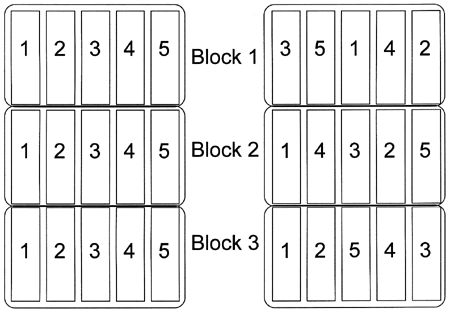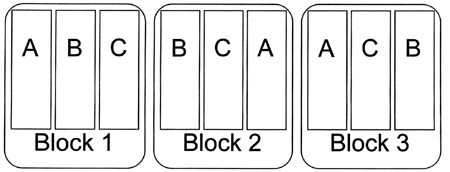The basic objective of plant breeding is the ultimate crop improvement. It results in development of high yielding varieties hybrids etc., over the existing cultivars and so on. The performances of the new varieties are confirmed from the results obtained from the field experiments. To be explained scientifically the field experiments are laid out following certain rules and the data thus collected are analyzed statistically. The steps involved in this process are explained here under.
Any designing of experiments involves three major steps.
1. Selection of experimental units
The objects on which the treatments are applied is known as experimental units. Eg. Plots in the field, plant, etc.,
2. Fixing of treatments
The objects of comparison are known as treatments. Eg. Varieties, spacing etc.,
3. Arrangement of treatments in the experimental Units
It comprises of three basic principles of design
Replication: repetition of treatments
Randomization: unbiased allocation of treatments to the experimental units

|
Fig. 1. Test plots on the left are not randomized. Plots on the right are randomized.
The numbers (1-5) represent the five treatments in this test |
Local control: minimizing the effect of heterogeneity of the experimental units
The objective of replication, randomization and local control is to minimize the Experimental Error (EE). EE is nothing but differences in the responses from the experimental unit to experimental unit under similar environments. Apart from these, EE can be reduced further by proper selection of the experimental units and choosing of most appropriate experimental design for a given number of treatment.
Types of basic experimental designs
1. Completely Randomized Design (CRD)
2. Randomized Block Design (RBD)
3. Latin Square Design (LSD)
Among these, RBD is the widely used design.
Laying Out of RBD
A. The experimental material (field) is divided first into blocks consisting of homogenous (uniform) experimental units. Each block is divided into number of treatments equal to the total number of treatments.
B. Randomization should be taken within each block and the treatments are applied following the random number table.
C. Collection and analysis of data: After the collection of data from the individual experimental unit (treatments) ANOVA (Analysis of Variance) table is formed.
The significance of the ANOVA table is that it indicates the sources of variation exhibited by the treatments, the magnitude of variation derived from different sources and their worthiness (significant/ non significant).
D. Computation of Critical Difference (CD)
Critical Difference is the difference between the treatment means, which places the treatments statistically as well as significantly apart. Otherwise if the difference of two treatments mean is less than CD it can be concluded both the treatments are on par.
RT : Row trial
Row trial is generally conducted in F3 and F4, when the seeds are not sufficient for replication with individual plant progeny rows. Each row consists of about 20 or more plants. Individual plants with desirable characteristics are selected from superior progeny rows. Pest, Disease and lodging susceptible progenies with undesirable characteristics are eliminated.
RRT – Replicated Row Trial
It is generally conducted from F3 generation onwards. Depending on availability of seeds, 3-4 more rows are grown for each progeny to facilitate comparison among progenies adopting suitable replications. Families, which have become reasonably homozygous may be harvested in bulk. From those families showing segregation, single plants are selected for characters under study. The breeder has to visually assess the yielding potential of progenies and reject the inferior ones in the field and the yield potential has to be assessed in the laboratory for confirmation.
PYT – Preliminary Yield Trial or Initial Yield Evaluation Trial (IYET)
It is conducted from F5 generation onwards. Preliminary yield trial with three or more replications are conduct to evaluated the comparative performance of the culture and to identity the superior cultures among them. The cultures are evaluated for plant height, lodging, pest and disease resistance, flowering time, duration and yield, etc., Quality tests may also be carried out. Standard commercial varieties must be included as checks for comparison. Ten to fifteen outstanding cultures, if superior to checks, would be advanced to the Advanced yield trails.
AYT – Advanced Yield Trial
Advanced Yield Trial is conducted from F8 generation on wards. The superior cultures identified from Preliminary Yield Trial are tested in Replicated Yield Trial. In this trial, the cultures are evaluated for yield, pest, disease and lodging resistance, duration, quality, etc.
MLT - Multi Location Trial
Multi location trial is conducted from F13 onwards for 3 years by the Research Station Scientists. Multi Location Trial are useful for suitability studies i.e. whether a particular culture is able to perform well in all the locations or not and whether the particular culture out yields all the other cultures developed by research stations and the check variety evaluated simultaneously. Based on the evaluation, superior and stable performing culture will be promoted to ART.
ART – Adaptive Research Trial
It is conducted after MLT for 3 years by the Department of Agriculture. Nearly 3-4 cultures are tested and based on the performance of 3 Years in the farmers field, the best culture over the check may be proposed to SVRC (State Variety Release Committee) for releasing.
If the SVRC finds that the cultivar is suitable for any particular area or through out the state, then the variety is released and is notified by the State Department of Agriculture. |


